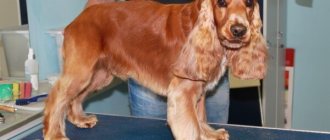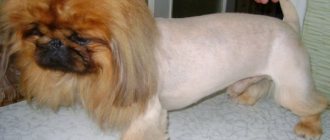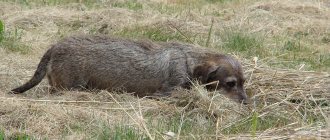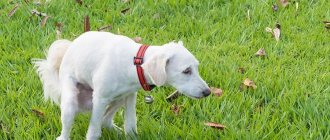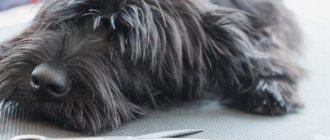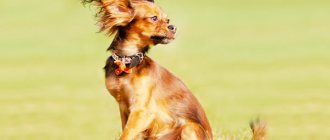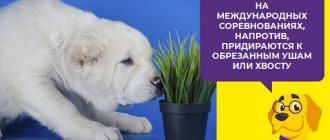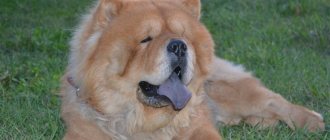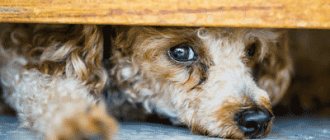There are two types of Cocker Spaniels: English and American. Despite the similar name, common ancestors and some external similarities, these dogs have different purposes. The English Cocker is a real hunter, while the American Cocker is slowly becoming a decorative breed, although he still has the instincts of a hunter. Both variations have long, silky hair, so the haircuts of the English Cocker Spaniel and the American Cocker Spaniel are similar and can be done at home.
When and why to cut a spaniel's hair
Grooming a Cocker Spaniel usually has two purposes:
- exhibition;
- hygienic.
For the exhibition, the dog must be cut to certain standards. But even if you are not going to exhibitions, long hair needs care. If you do not comb and cut your spaniel, it will look untidy and unsightly, and the hairs will become tangled, causing discomfort to the animal. An unkempt coat is more difficult to wash, food gets stuck in the hair around the muzzle, and bangs get into the eyes.
The spaniel is cut 3-4 times a year. If the individual is for exhibition, grooming is updated several days before each exhibition. Pets are often cut before summer, as short hair makes it easier to track ticks.
Features of haircuts
The English and American cockers have common patterns:
- paws and tail are well brushed, to the maximum length, they are only given shape;
- the coat should not be excessively curly, only minimal waviness is acceptable;
- The back, head, neck, muzzle and area around the anus are cut short.
But there are certain breed nuances that cannot be ignored.
Features of the American Cocker Spaniel's haircut
Wool is the main advantage of this breed. In the 21st century, the American Cocker Spaniel became a decorative breed. Haircut involves several main points:
- Under no circumstances should you shave your back with a machine. This deteriorates the quality of the hair. If there is a downy undercoat on the back, it is combed out with a furminator comb or plucked with rubber fingertips (this is called stripping).
- If the coat is too thick, then the excess volume is removed with thinning scissors.
- Ideally, the skirt should extend to the floor. If there is not enough fur (usually young or elderly animals, recently whelped bitches have not enough fur), then you need to make sure that the boundaries of the transitions are smooth.
- On the neck, muzzle, and upper third of the ears, short stubs 1 mm long are left.
An American's first hairstyle is created at 2-3 months, after which hygienic styling is done once every 3-4 weeks, and about once a quarter the American Cocker Spaniel is given a full grooming. An experienced specialist knows better how to cut an American Cocker Spaniel's hair, but if the owner has the desire and the tools, he can also cope with this task.
Features of the English Cocker Spaniel's haircut
The coat of this breed is not the main source of pride, so grooming an English Cocker Spaniel is aimed rather at emphasizing the dog’s appearance and hiding flaws. Main differences from an American haircut:
- The head and muzzle are always smooth to highlight the beautiful contours. The hair is shaved with a clipper against the growth direction.
- A triangle is left on the chest, and the feathering on the front legs should only be on the back.
- The upper thighs are trimmed and the hocks are clipped short.
Otherwise, the haircut styles are not very different and are almost identical for the two sister breeds.
Where to start?
Specify what kind of veterinarian you are looking for
Receive price quotes from veterinarians
Communicate directly and choose the best one for you
join the discussion
Share with your friends
The coat of some dogs requires especially careful care. Brushing, preparing for a show, and grooming a cocker spaniel are among these not very pleasant, but absolutely necessary responsibilities of owners. Mandatory grooming takes time, but allows you to maintain your pet’s abundant coat in show condition. However, even if you don’t plan to send your dog to a dog show, a properly selected haircut will help ensure the animal’s comfort both in winter and summer.
English and American Cocker Spaniels require professional grooming. It includes thorough combing of the coat, washing it, and removing tangles. In addition, the dog needs back trimming, silhouette work with thinning scissors, and regular hygienic treatment of certain areas of the body.
Styles and types of hairstyles
Requirements for a hairstyle are put forward based on her needs. For pets, sometimes some modeling touches are made to emphasize their gender.
Hygienic and exhibition
It is better to entrust the exhibition option to a professional. Even if you want to prepare your pet for the competition yourself, it’s better to go to the groomer a couple of times - you can see the whole process and ask questions if something is not clear. For the exhibition, the dog must be cut in a certain way; the most that the groomer can do is play with the contours to highlight the advantages and disguise the shortcomings.
Hygiene options are subject to less stringent requirements. Here you can vary the length of the skirt. The following models are popular among owners
- trimming with maximum length - for responsible and diligent owners, practically an exhibition standard;
- trimming with medium length - the dog looks like an ordinary spaniel, but hair care is simpler;
- trimming with a short skirt;
- for a poodle – the dog is given paw-like legs and a poodle head;
- Shaving with a clipper is the harshest option; it is chosen by owners of dogs that have trouble combing their hair; Once a year, usually before summer, the poor fellow is taken out of the tangle and left to grow and fall off until the next shave.
Owners of pet-class animals prefer regular hygienic haircuts - they make grooming easier and make the pet’s appearance neat.
For boys and girls
The show haircut of a Cocker Spaniel is strict and does not imply gender differences.
“Sofa” girls can have a longer skirt than males, have bangs and attach bows and hair clips. Boys are left with a skirt of medium or short length, but are often asked to leave a “curtain” under the tail to cover the “household”, even if everything else is shaved bald. A poodle hairstyle is usually ordered for males.
What tools will you need?
To groom your pet you will need the following tool:
- hair dryer;
- tangle cutter;
- a special clipper with attachments (the clipper is not suitable for humans, since dogs have a different hair structure);
- straight scissors;
- rounded scissors for decorating paws;
- thinning scissors;
- comb-furminator, trimming knife or fingertips for stripping the back;
- wide-toothed comb;
- brush.
A grooming table is quite expensive, but if you plan to groom your pet often, this purchase makes sense. The table has a rubberized platform on which the dog will not slip, the height is adjustable to suit your height, and a rod with a lock securely fixes the furry client and prevents escapes.
Procedure at home step by step
The scheme for creating a hygienic hairstyle is simple, and it can be applied with equal success to both English and American cockers.
- Before you start trimming the dog’s fur, you need to wash it and dry it with a hairdryer, comb it, and if there are tangles, sort them out.
- The back, croup and withers are combed with a furminator, a trimming knife, or plucked using fingertips. The head can be trimmed or shaved.
- The muzzle, the inside and the outer upper third of the ears are shaved with a machine. The neck is shaved down to the collarbones, leaving a triangle on the chest. English spaniels have the hair removed from the front of their paws, leaving the feathering at the back.
- The hair under the tail is removed using a machine.
- Using straight scissors, shape the ears, draw a line of feathers on the paws and tail, and trim the desired length of the skirt. For the English, the fur on the hind paws is smoothed out.
- Using rounded scissors, cut the hairs between the toes and make neat oval paws. At the same stage, the animal's claws are trimmed.
Even if you don't know how to cut a cocker spaniel at home, you can use these instructions. If you did everything correctly, you will get a handsome spaniel that looks almost like a show photo.
History of the Russian Hunting Spaniel breed
At the end of the 19th century, various representatives of the cocker spaniel breed were brought to Russia.
Unfortunately, these small, squat dogs turned out to be not very suitable for bird hunting conditions in Russia. Hunters at that time had a growing need for a hardy and unpretentious small-sized gun dog. At the beginning of the twentieth century, admirers of the new breed selected tall-legged and temperamental individuals for breeding, and brought springers from abroad to mix blood with different types of livestock. By the end of the 30s of the twentieth century in Russia there were a large number of spaniels that did not fit into any group of similar breeds. They had common characteristics, although they were no longer cockers or springers, but they did not reach the level of the Russian hunting spaniel.
The development of the new breed continued after the end of the Great Patriotic War, when various representatives of the spaniel family began to be brought to the USSR from abroad. Thanks to hard and diligent work, from the livestock that remained during the war and imported individuals, the breeders were able to develop a new type - the Russian hunting spaniel.
1951 The first breed standard was developed, meeting the requirements and demands of hunters in the USSR. In 1966, the standard was slightly modified. Today, the Russian hunting spaniel is very popular in Russia.
The ancestors of the breed were Spanish dogs brought to England in the 14th century. They were actively used in hunting to catch wild birds.
In the 17th century, breeders began to think about improving the breed and began crossing them with dogs like the King Charles. Official recognition of the breed occurred in 1893, and the standard was approved at the beginning of the 19th century.
Cocker Spaniel
Breeders have worked on a variety of spaniels. In the mid-20th century, the American Cocker Spaniel breed was developed. Sometimes this breed is confused with the Scottish Setter due to its external resemblance.
There are various interesting facts about cocker spaniels. Here are some of them:
- A hunting dog tracks prey while standing on its hind legs. Then it jumps high, overcoming thickets or a snowdrift and begins the pursuit.
- In some countries the breed is known as the "bird hound".
- Thanks to their developed sense of smell, they are used in law enforcement agencies, customs, where they track drugs, explosives, etc.
The American Spaniel looks different from the British Spaniel.
Care after grooming
After grooming, you need to maintain the condition of your pet’s hair so that it does not turn into a matted felt boot before the next haircut. Care is not that difficult, but requires regularity and some persistence on the part of the owner.
Bathing
When walking through mud, long and medium coats should be protected with waterproof overalls. A cocker is given a full bath no more than once every 1-1.5 months; many owners try to combine a “bath day” with nail trimming. Cockers are washed with special shampoos for long hair; it is advisable to select the product according to the color of the hair. After the bath, the furry friend is dried with a towel, dried with a hairdryer and combed, removing tangles if necessary.
Combing
They comb the cocker every other day, if the dog likes the procedure, then you can do it every day. Combing has a beneficial effect on the skin, improving blood circulation and preventing tangles from matting. First comb the dog with a brush, then go over the long part with a comb with sparse teeth. If tangles have formed somewhere (and this can happen even with frequent combing, especially in the season when you have to put overalls on your pet), then they need to be carefully disassembled. Sprays can help a little to make it easier to comb.
Caring for the Russian Hunting Spaniel
Russian hunting spaniel photo in the yard with his favorite ring
Coat: needs to be brushed regularly, 1 – 2 times a week, with a metal comb. This way you can prevent the appearance of tangles and give a well-groomed appearance. Combing starts from the head and ends with the tip of the tail. Comb should be in the direction of hair growth. To make combing easier, the surface can be sprinkled with a weak solution of acetic or citric acid; it protects the dog well from infection by external parasites.
Solution proportions: add 1 tablespoon of citric or acetic acid to 1 liter of hot water, mix the contents and cool to a temperature of 40 °C. If there is no balm, you can rinse your hair with this solution after bathing.
Russian Hunting Spaniel puppies have short and sparse hair, but it should be combed. A massage brush made of natural hair is perfect for this procedure; it will not damage the baby’s delicate skin and will provide good massage and blood circulation.
Bathing: recommended when dirty or 1-2 times a month. A special dog shampoo with conditioner and rinse can be purchased at any pet store; you should choose according to your coat type. Make sure that the detergent does not dry out the skin; this can be recognized by frequent itching or the appearance of dandruff. In this case, change your shampoo.
After bathing, the spaniel's coat is treated with balm or cosmetic oil. Thanks to these products, the hair becomes elastic, and tangles appear less often under the arms, in the groin area and on the hocks.
Haircut: You can cut your puppy's hair for the first time at the age of 3 months, depending on how much hair grows. There are 2 types of haircuts for the Russian Hunting Spaniel:
- Full (done every 2 – 3 months using a groomer)
- Hygienic (every 2 weeks, overgrown hair on the paws, around the anus and ear holes is trimmed)
Photo of Russian hunting spaniel and small puppy
The fur on ROS's back cannot be cut. At the age of 8 months, puppy fluff begins to be rejected, and the hair on the back looks unkempt. Use a short-toothed comb that removes lint well. Carry out the procedure every day, combing small areas, so you are less likely to injure the dog’s delicate skin.
Many owners want to shave it all off, let a new one grow, but remember, once the hair on the back of a Russian Hunting Spaniel is cut, it will never grow back smooth and even. She will constantly bristle, which is a significant drawback for a show dog.
The area around the anus is trimmed for hygiene purposes. The tail is cut into a wedge shape, and tangles in the groin area are cut off. On the paws, it is trimmed in the vicinity of the pads, between the toes and in a circle just above the claws, so that the hair does not come into contact with the ground while walking.
Ears: folded, need regular inspection and ventilation. It's easy to air out your pet's ears, just flap them like wings for a few minutes. Clean your ears once a month or as needed, with a cotton swab dipped in warm water or a weak peroxide solution. Wipe the inside of your ear to remove dust and wax. A healthy spiniel does not have a lot of sulfur accumulation and does not have an unpleasant odor.
If your pet often shakes its head, as if shaking something out of its ear, a lot of wax accumulates, and an unpleasant odor emanates, be sure to seek help from a veterinarian. The main cause is ear inflammation, but only a specialist can make the correct diagnosis and prescribe treatment.
Eyes: of a healthy Russian hunting spaniel, clean, without souring or tearing. Once a week, as a preventive measure, wipe your eyes with weak tea leaves or a decoction of chamomile flowers.
Claws: trimmed with a nail clipper - guillotine once a month. If he is active and runs a lot, the procedure can be done less frequently. But in this case, watch the condition of the claws; they should not be too long or curled. This leads to lameness.
Ticks and fleas: Be sure to treat your Russian Spaniel with parasite repellent (Frontline, Advantix) once a month. The drug is applied to the withers, do not bathe for 10 days.
Hunting breeds are more susceptible to tick infestation than others, as they spend more time in the forest, running through thickets. After a walk or hunt, be sure to inspect your pet for parasites. If you find a tick, do not be alarmed; carefully remove it and treat the bite site with brilliant green. After this, monitor the spaniel's condition for several days. If he is active, eats with appetite, and his urine is clear, you are lucky, the tick is not contagious.
But if you notice lethargy, lack of appetite, increased body temperature (40 - 42°C), red or brown urine, immediately go to the veterinarian. Only a specialist can save the dog.
Due to constant shedding, the English Cocker Spaniel has to be brushed daily. After a carefully carried out procedure, dead hairs are removed and the appearance of the four-legged animal is immediately transformed. With regular care, the coat will always look well-groomed and shiny.
The dog enjoys the brushing process
The English Spaniel does not require frequent water treatments. Frequent bathing affects the dog's coat. It loses its former shine, and dandruff appears. Due to dry skin, peeling occurs, which leads to dissatisfaction of the animal.
The owner should pay attention to the spaniel's haircut. Breeders resort to professional help from a groomer. It is enough to carry out the procedure once a quarter.
We invite you to familiarize yourself with Smecta for cats: instructions for use, dosage
Correct haircut
There are several techniques for grooming hair. Most often they are combined:
- Stripping is plucking out wool hairs with a special knife.
- Placking - hairs can be plucked with your fingers.
- Clippercut is an ultra-short haircut with a clipper.
- Blending is cutting wool using scissors.
- Flatvec is a standard clipper haircut.
The optimal haircut option is to treat the head with a trimming knife, stripping is suitable for the body, and the hair on the legs is shortened with scissors. The hair between the fingers is also cut off.
How to accustom a puppy and an adult dog to a haircut
A spaniel should be taught to comb itself from childhood, and it is better to do it right away on the grooming table. Some owners do not strive to care for the baby’s still short hair, and this is a mistake, since the purpose of this action is to accustom him to care items and procedures.
- First, the puppy is taught to stand on the table. At this time, you can let him smell the combs, be sure to stroke and praise him like a child. If he tries to chew brushes and combs, stop this behavior.
- When the puppy feels calm and confident on the table, you can try brushing him. This is done carefully and gently: you should not pull the fur and hurt the baby, so as not to form a negative impression. It is better to choose the moment when the puppy has played enough, is tired and is in a sleepy state.
- The older the puppy, the longer the brushing time. But if you do this regularly, the process is unlikely to take you longer than 10-15 minutes, even with long hair, because the vast majority of time is spent sorting out tangles.
If you have not taught your dog to groom and groom since childhood, then you have little chance of making him love this activity. But it is quite possible to teach patience. Actions with an adult dog will be approximately the same as with a baby, but you may encounter more active resistance.
Grooming your Cocker Spaniel should be regular, and then your friend will look neat and tidy, regardless of whether he is a show star, a hunter, or a sofa pet.
How to choose a puppy
The development of cubs is divided into four large periods - neonatal, transitional, socialization and juvenile. At each of them, important physiological and behavioral changes occur.
Neonatal
The period lasts from birth to 2 weeks:
- 1-3 days. Newborn puppies are completely dependent on their mother and are absolutely helpless. The main thing for them is to get enough milk.
- 5-7 days. The cubs are not yet able to defecate, but their ears begin to open and their noses become colored. They distinguish the smell of the mother, the taste of milk, feel heat and cold.
- 8-10 days. Puppies double their weight, react to heat, begin to squeak and whine in response to stimuli.
- 10-15 day. Their eyes open, but the babies still see poorly, which does not prevent them from learning to crawl.
During this period, it is important for the owner and breeder to provide a cozy “nest” - to protect the mother and cubs from noise and drafts, to maintain optimal air temperature and room illumination.
Transition
A short but important stage of development (2-3 weeks):
- 16-17 days. The hearing organs begin to function - the puppies distinguish where interesting sounds are coming from and crawl towards them. They know how to stand on their paws and imitate their mother’s behavior.
- 18-20 days. Along with the appearance of adipose tissue, thermoregulation develops. Puppies react to stimuli and develop a defensive reflex.
- 21-24 days. The kitten hears and sees perfectly, its body temperature is regulated. Teeth begin to erupt. The kids play among themselves, with their mother, and learn to wag their tails.
The owner gets to know the kids and gives them the opportunity to explore the house. Offers soft complementary foods and carries out first deworming.
Socialization
Quite a long period (3-12 weeks):
- 24-28 days. Meat becomes more interesting than milk. The mother teaches the puppies to interact with the world, drink water, eat, bite.
- 30-35 day. A one-month-old puppy is no longer tied to its “den.” The cubs begin to erupt with fangs and false teeth. They begin to respond to the nickname - it’s time to learn the first commands and move on to initial training.
- 45-55 day. The nervous system of the kitten is formed. He actively explores the world and learns new commands.
- 8-9 weeks. “Period of fear” - the baby must be protected from everything that can frighten him. The animal is finally transferred to solid food. At this time, it is easiest to accustom the kitten to the toilet.
- 2 months. The baby is given the first vaccination. His baby teeth are fully formed. Puppies sleep less, play most of the day - hunting, defense, pursuit, attack. The dog is already able to control the force of the bite - during this period the person sets the boundaries of what is permitted for the kitten.
- 3 months. Carrying out the second vaccination. The Cocker Spaniel can be taken for walks on a leash.
By the end of the socialization period, the puppy knows how to communicate with animals and people, understands “dos” and “don’ts,” and knows simple commands.
Juvenile
The longest stage is from 12 weeks to puberty. Along with it, the active development of the young dog slows down:
- 12-16 weeks. An animal in search of its position in the “pack”. It is important for the owner to firmly, but without violence, show the dog his place, and not allow him to dominate people.
- 6-8 months. Baby teeth are completely replaced by permanent teeth. Girls begin their first heat - the puppy period ends. The weight of a cocker spaniel is 80% of the weight of an adult.
At 10-12 months, the physiological development of the dog stops. His behavioral attitudes and habits are also fully formed.
When choosing a puppy, relying only on the photo and cost will be a mistake. The choice is best made personally, based on the following points:
- Age. You cannot pick up a puppy under the age of 1.5 months; he still needs maternal care. An animal older than six months will be more difficult to train, since it is already accustomed to its environment.
- Floor. Females are more obedient than males.
- Behavior. An active puppy is healthy. If a dog lunges at humans and other puppies during play, it is likely that it will grow up to be aggressive.
- Standard. In addition to visual parameters, the breeder must provide documents for the puppy. To make sure that the puppy is purebred, you can familiarize yourself with its pedigree.
A spaniel puppy should be playful, but not angry.
